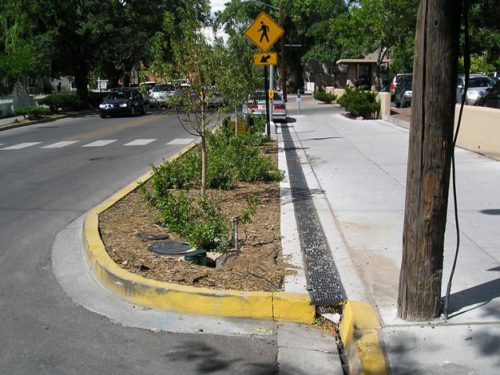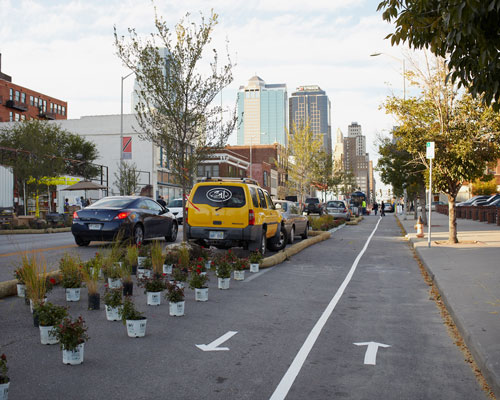Shared Streets
Walnut Street, which acts as Murphysboro’s Main Street, is designated a state highway, bringing an average of 12,000 vehicles per day through the community. While this presents an opportunity for potential patrons, the amount of traffic, which includes heavy truck vehicles, poses a serious challenge to the City in terms of providing residents a safe and walkable downtown.
The following recommendations would enable the city to be able to implement its vision for the future needs with respect to beautification, signage, improved connectivity, and traffic-calming solutions.
Shared Streets
A shared–street or complete street is designed to be safe and accessible for all users, including pedestrians, bicyclists, and motorists. People of all ages and abilities should be able to move safely along and across streets in a community, regardless of how they are traveling. Shared streets are not only good for residents’ well-being, but for neighborhood and local businesses as well.
Shared-streets typically calm traffic, increase bicycle transportation, and attract pedestrians. The design is site-specific and can include any number of elements such as protected bike lanes, sidewalks, street furniture, landscaping, planters, pedestrian signals, parallel parking in buffers, curb extensions, and ample and adequate crosswalks.
Current Benefits
There are currently many positive design elements implemented along Walnut Street that support a shared streets plan:
- Speed Limit: the current speed limit downtown is 25 MPH.
- Road Diet: Starting at 6th Street, the 4-lane road converts to 3-lanes: 2–directional lanes and a center turn lane. This improves pedestrian safety when crossing busy roads.

Source: Federal Highway Administration, US Department of Transportation
- On-street parking: Providing on-street parking narrows the road further and provides a row of protection for pedestrians from moving vehicles.
- Signaled crossing: Crosswalks at major intersections have stoplights that include pedestrian activated signals to provide safe passage across Walnut Street.
Proposed Improvements
Below is a list of proposed improvements to help slow down vehicular traffic and make the central business district of Walnut Street more pedestrian friendly.
- Crosswalks: Existing crosswalks could be improved with new striping to better highlight intersections. An additional step would be to install crosswalk murals to further establish the area as a walkable district for pedestrians.
- Curb Extensions: Curb extensions or bumpouts increase the overall visibility of pedestrians by aligning them with the parking lane and reducing the crossing distance for pedestrians. The unused parallel parking spaces marked with an “X” would be a great place to apply curb extensions.

Source: National Association of City Transportation Officials
https://nacto.org/publication/urban-street-design-guide/street-design-elements/curb-extensions/
- Pinchpoints: Similar to curb extensions, pinchpoints located at mid-block restrict motorists from operating at high speeds on local streets and significantly expand the sidewalk realm for pedestrians.

Source: National Association of City Transportation Officials
https://nacto.org/publication/urban-street-design-guide/street-design-elements/curb-extensions/pinchpoint/
- Lighting: Installing overhead lighting for the purpose of pedestrian walkways will help drivers distinguish between a walkable, downtown district and a highly illuminated highway which signals drivers that they have entered a new and different zone, and compels them to slow their driving speed.
- Wayfinding: The purpose of wayfinding is to highlight key points of interest for passersby. It also indicates a gathering place and is a visual cue for drivers to slow down. See Wayfinding under the Public Art section of this plan by clicking HERE.
- Street Trees/Planter Boxes: Trees and planter boxes narrow a driver’s visual field and create rhythm along the street. Similar to curb extensions, street trees or planters could be installed in the unused “X” parking spots parallel to Walnut Street.
The Alley
Alleyways are traditionally used as a service access to the main street and adjacent roads. There has been a recent push to activate these underutilized areas as public gathering spaces with café seating, lights, murals, and art installations, live music, and other activities. The Passages in Chattanooga, TN is one great example of turning an underutilized space into a center of culture for their downtown Innovation District. Art installations are changed periodically to keep people coming back to the area, which then turns into opportunities for other events and patronage of downtown businesses.

Source: The Passages, Innovation District in Chattanooga, TN
The Warsaw Alley in Warsaw, IN is another community that is reclaiming its alley space. They recently raised over $100,000 to install tables, chairs, lighting, landscaping, art, and free Wifi. This space is very similar to the alley off Walnut Street between the Hardware and Pets shop and George’s Resale building. Closing this space off to vehicles and utilizing it as a pedestrian passage to main street connecting to available parking lots would further support the downtown businesses. People would have a parking amenity that directly leads to downtown through a unique and inviting walkway encouraging people to visit more shops and spend money in the community.

Source: Warsaw Alley via Patronicity, a crowd-funding website
https://www.patronicity.com/project/the_warsaw_alley#!/





